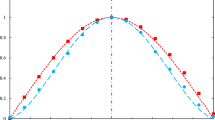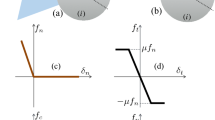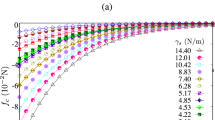Abstract
Discrete Element Method is used to simulate the impact of agglomerates consisting of autoadhesive, elastic-plastic primary particles. In order to explain the phenomenon that the elastic agglomerate fractures but the elastic-plastic agglomerate disintegrates adjacent to the impact site for the same impact velocity, we increase the impact velocity and lower the yield strength of the constituent particles of the agglomerate. We find that increasing the impact velocity can lead to the increased number of yielded contacts, and cause the elastic-plastic agglomerate to disintegrate faster. Mostly importantly, the energy dissipation process for the elastic-plastic agglomerate impact has been investigated together with the evolutions of the yielding contacts, and evolutions of velocity during impact.
Access provided by CONRICYT-eBooks. Download conference paper PDF
Similar content being viewed by others
Keywords
- Impact Velocity
- Discrete Element Method
- Discrete Element Modelling
- Distinct Element Method
- Interparticle Contact
These keywords were added by machine and not by the authors. This process is experimental and the keywords may be updated as the learning algorithm improves.
1 Introduction
In the last three decades or so, numerical simulations have been extensively used to simulate impact fracture of agglomerates. Significant research findings have been made by Thornton and co-workers [1–5] by using the discrete element method [6, 7] based upon contact mechanics [8]. In the meantime, many other researchers have also conducted extensive researches on agglomerate impact to examine various possible influence factors, which include interface energy [9], particle size and bond strength [10, 11], energy dissipation [12], and impact angle [13, 14]. Very recently, we have investigated agglomerate impact during which process it involves particle plastic deformation at contacts during the agglomerate impact [15]. We find that that the elastic agglomerate fractures but the elastic-plastic agglomerate tends to disintegrate adjacent to the impact site for the same impact velocity. We believe that such a phenomenon is related to the high stress concentration at particle contacts during particle collisions in the course of granular material impact, and the resultant inter-particle energy loss which may directly affect the breakage mechanisms of the agglomerate. Hence, this study focusses specifically on this problem and preliminary research results obtained are presented in the following sections.
2 Preparation of an Agglomerate
The current version of the DEM code (named GRANULE) for granular dynamics in this study is capable of modelling frictional, elastic, adhesive or non-adhesive spherical particles with or without plastic yield at the interparticle contacts. The model originated as the distinct element method (DEM), [6] which was extended to 3D applications by the development of the program TRUBAL, Cundall [7]. In this research, we have adopted the adhesive, elastic contact force model of Thornton and Yin [16] and the adhesive, elastic-plastic contact force model of Thornton and Ning [17] for the agglomerate impact simulations reported below. Full theoretical details of these models can be found in [8, 16, 17].
The agglomerates used in this research is the same as the ones used in our recent paper [15], which consisted of 10,000 primary particles (spheres) with an average diameter of 20 μm. The particle size distribution is shown in Fig. 1. The material properties of the primary particles in the agglomerate were specified as: Poisson’s ratio v = 0.3, Young’s modulus E = 70 GPa, density ρ = 2650 kg/m3 and the coefficient of interparticle friction μ = 0.35. As prepared, the final porosity of the cuboidal agglomerate was 0.417, with a bulk density of 1153.1 kg/m3. The coordination number of the cuboidal agglomerate was 3.516, corresponding to 14,993 contacts in the agglomerate. The value of interface energy Γ = 2γ = 1.0 J/m2. Figure 2 illustrates the cuboidal agglomerate in different views. The agglomerate’s dimensions were 0.497 mm × 0.445 mm × 0.447 mm. The detailed procedures used to prepare the agglomerate can be found in [15].
3 Impact of an Elastic Agglomerate
To give a full picture of our research work, we now have to describe some of the fundamental results produced in [15]. For the purpose of comparison, we first carried out agglomerate impact simulations which was composed of only elastic particles. By defining an unrealistic high yield strength as 7.0E30 Pa, plastic deformation of the particles was prohibited. The cuboidal agglomerate was oriented to have a collinear edge impact in which case observations of fracture planes can be easily made. Impact simulations began by setting a velocity to all the agglomerate particles in the vertical direction. Figure 3 illustrates the results of an elastic agglomerate impacting the target wall for a speed of 2 m/s, and shows clearly that the agglomerate fractures.
4 Impact of an Elastic-Plastic Agglomerate
We then conducted numerical experiments of impact of an elastic-plastic agglomerate. Several impacts were simulated using different values for the limiting contact pressure p y at inter-particle contact ranging from 10 GPa down to 1.8 GPa. It was found that particles in the damage zone of the agglomerate start to yield for p y ≤ 3 GPa. Therefore, we first set p y = 2.3 GPa as a typical case in the following study to investigate impact damage for elastic-plastic agglomerates.
Figure 4 illustrates the snapshot of the agglomerate after its impact (the picture was taken at the same moment as for the elastic impact, i.e. at time = 100 µs). Surprisingly, unlike the impact of elastic agglomerate (see, Fig. 3b) when the agglomerate was fractured, the agglomerate consisting of elastic-plastic particles did not fracture completely but largely disintegrated. It is clear that, in the simulations of impact of the elastic-plastic agglomerate, the agglomerate used is exactly the same as the one which is composed of elastic particles except for the predefined limiting contact pressure, i.e. p y = 2.3 GPa. We concluded that the only reason for the elastic-plastic agglomerate not fracturing completely under the same conditions is that certain particles must have undergone plastic deformation, which results in extra dissipation of kinetic energy [15].
In order to study the effect of limiting contact pressure (i.e. a multiple of the yield stress i.e. p y = 2.5σy), we then set p y = 1.8 GPa to examine more of the impact process for elastic-plastic agglomerates. Figure 5 shows the comparisons of average velocities of the elastic and elastoplastic agglomerate during impacts. It suggests that smaller limiting contact pressure results in faster reduction of the speed of the agglomerate impacting the target wall.
In Fig. 6, number of contact at which yield has occurred has been traced for the elasto-plastic agglomerate impacts especially for the period from beginning to the peak when the number of yielded contacts reach its maximum. It can be seen that for the case of P y = 1.8 GPa, the number of yielded contacts can reach up to ca. 215, while it is around 15 for the case of P y = 2.3 GPa. The effect of increasing impact velocity from 2 to 4 m/s for the case of P y = 2.3 GPa is to cause the number of yielded contacts to increase at an accelerated pace, reaching up to around 90.
The results shown in Fig. 6 give enough explanations as to why the agglomerate has been retarded with a faster reduction in its impact speed for the case of low yield strength as shown in Fig. 5. That is, smaller yield stress can lead to much increased number of contacts at which particles undergo plastic deformations which then consume more kinetic energy that is, otherwise, used to fracture the agglomerate. The overall effect is to cause the agglomerate tends to exhibit disintegration rather than fracture when either the limiting contact pressure is decreased or the impact velocity is increased for the elastoplastic agglomerate impact.
To give further evidence to this discovery, energy dissipated by plastic deformation for elastoplastic agglomerates during impact are shown in Fig. 7. It can be seen that in both cases of elastoplastic agglomerate impacts, energy consumed by plastic deformation increases along time to a peak time, then decreases along time. It is apparent that smaller limiting contact pressure P y = 1.8 GPa has resulted in much larger amount of energy consumption than that for P y = 2.3 GPa. Typically, at around peak time (ca. 32 µs for P y = 1.8 GPa and 35 µs for P y = 2.3 GPa), the energy dissipated by plastic deformation counts 5.67204E−08 (J) (i.e. 24.8 % of the total initial kinetic energy) for the case of P y = 1.8 GPa, in contrast to the Fig. 2. 48465E−08 (J) for the case of P y = 2.3 GPa which is account for 10.8 % of the total initial kinetic energy of the agglomerate. This again gives arise to the explanation as to why an elastoplastic agglomerate impact tends to exhibit disintegration rather than fracture.
5 Conclusions
Impact of elastic-plastic agglomerate has been investigated using discrete element modelling in this paper. Our previous research findings [15] suggest that the elastic-plastic agglomerate tends to disintegrate during impact in contrast to the elastic agglomerate which fractures, and this needs a more convincing explanation in relation to plastic deformation and kinetic energy loss. In this research, it was observed that impact of the agglomerate was retarded with the increased number of yielded contacts and the decreased speed of motion when the limiting contact pressure was lowered. The simulation results show that the number of yielded particles is sensitive to the limiting contact pressure. This study has also examined the effect of varying the limiting contact pressure on the kinetic energy dissipated by plastic deformation. Preliminary results show that the energy dissipated at yielded contacts is greater for smaller limiting contact pressure. Due to such greater additional energy loss, the elastic-plastic agglomerate tends to disintegrate during impact.
References
Thornton, C., Yin, K.K., Adams, M.J.: Numerical simulation of the impact fracture and fragmentation of agglomerates. J. Phys. D Appl. Phys. 29, 424–435 (1996)
Thornton, C., Ciomocos, M.T., Adams, M.J.: Numerical simulations of agglomerate impact breakage. Powder Technol. 105, 74–82 (1999)
Kafui, K.D., Thornton, C.: Numerical simulations of impact breakage of a spherical crystalline agglomerate. Powder Technol. 109(1–3), 113–132 (2000)
Thornton, C., Liu, L.F.: How do agglomerates break? Powder Technol. 143–144, 110–116 (2004)
Liu, L.F., Kafui, K.D., Thornton, C.: Impact breakage of spherical, cuboidal and cylindrical agglomerates. Powder Technol. 199(2), 189–196 (2010)
Cundall, P.A., Strack, O.D.L.: A discrete numerical model for granular assemblies. Geotechnique 29, 47–65 (1979)
Cundall, P.A.: Computer simulations of dense sphere assemblies. In: Satake, M., Jenkins, J.T. (eds.) Micromechanics of Granular Materials, pp. 113–123. Elsevier, Amsterdam (1988)
Thornton, C.: Granular Dynamics, Contact Mechanics and Particle System Simulations—A DEM Study. Particle Technology Series, vol. 24. Springer, Dordrecht (2015)
Moreno-Atanasio, R., Ghadiri, M.: Mechanistic analysis and computer simulation of impact breakage of agglomerates: effect of surface enegy. Chem. Eng. Sci. 61, 2476–2481 (2006)
Ning, Z., Boerefijn, R., Ghadiri, M., Thornton, C.: Effects of particle size and bond strength on impact breakage of weak agglomerates. In: Behringer, R.P., Jenkins, J.T. (eds.) Powders & Grains 97, pp. 127–130. Balkema, Rotterdam (1997)
Metzger, M.J., Glasser, B.J.: Numerical investigation of breakage of bonded agglomerates during impact. Powder Technol. 217, 304–314 (2012)
Moreno-Atanasio, R.: Energy dissipation in agglomerates during normal impact. Powder Technol. 223, 12–18 (2012)
Moreno, R., Ghadiri, J., Antony, S.J.: Effect of the impact angle on the breakage of agglomerates: a numerical study using DEM. Powder Technol. 130, 132–137 (2003)
Tong, Z.B., Yang, R.Y., Yu, A.B., Adi, S., Chan, H.K.: Numerical modelling of the breakage of loose agglomerates of fine particles. Powder Technol. 196, 213–221 (2009)
Liu, L., Thornton, C., Shaw, S.J., Tadjouddine, E.M.: Discrete element modelling of agglomerate impact using autoadhesive elastic-plastic particles. Powder Technol. 297, 81–88 (2016)
Thornton, C., Yin, K.K.: Impact of elastic spheres with and without adhesion. Powder Technol. 65, 153–166 (1991)
Thornton, C., Ning, Z.: A theoretical model for the stick/bounce behaviour of adhesive, elastic-plastic spheres. Powder Technol. 99, 154–162 (1998)
Acknowledgments
The authors are grateful for the financial support from the Natural Science Foundation of Jiangsu Province of China (BK20131179).
Author information
Authors and Affiliations
Corresponding author
Editor information
Editors and Affiliations
Rights and permissions
Copyright information
© 2017 Springer Science+Business Media Singapore
About this paper
Cite this paper
Liu, L., Thornton, C., Shaw, S.J. (2017). Energy Dissipation During Impact of an Agglomerate Composed of Autoadhesive Elastic-Plastic Particles. In: Li, X., Feng, Y., Mustoe, G. (eds) Proceedings of the 7th International Conference on Discrete Element Methods. DEM 2016. Springer Proceedings in Physics, vol 188. Springer, Singapore. https://doi.org/10.1007/978-981-10-1926-5_12
Download citation
DOI: https://doi.org/10.1007/978-981-10-1926-5_12
Published:
Publisher Name: Springer, Singapore
Print ISBN: 978-981-10-1925-8
Online ISBN: 978-981-10-1926-5
eBook Packages: Physics and AstronomyPhysics and Astronomy (R0)











